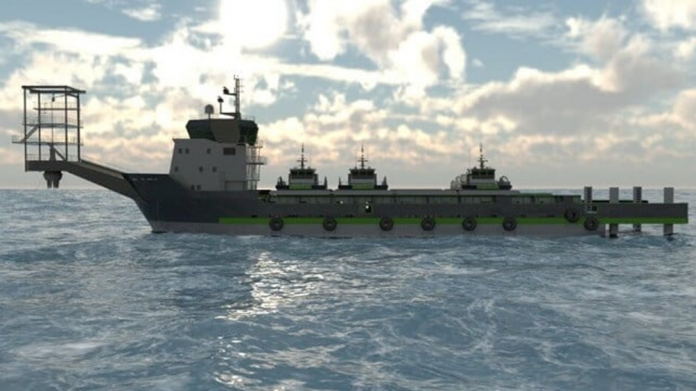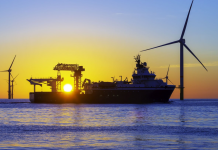
A start-up based in Canada has come up with a unique solution to speed the transition of offshore wind service vessels to hybrid or fully electric operations. Zephyrus Marine is a collaboration between vessel manufacturers, naval architects, battery manufacturers, and infrastructure electrical charging specialists and through this collaboration is developing a concept with a mother-daughter vessel approach to service offshore wind farms.
Zephyrus reports it has signed a memorandum of understanding (MOU) with Japanese shipbuilder Mirai Ships to build the Zephyrus Zero Carbon Offshore wind service vessel which is designed to support electric vessel operations and meet the harsh weather conditions with year-round rough seas off parts of Japan. Ad Hoc Marine Designs will be providing the design for the zero-emission Crew Transfer Vessel which will incorporate Shift Clear Energy’s PwrSwäp technology. Class NK has approved the energy storage system which will allow crew transfer vessels to swap modular battery systems to support zero-emission service to the Japanese offshore wind sector.
“We need to make it easy for shipowners and the offshore wind sector to go zero carbon,” said Rob Stewart, Director at Zephyrus. “By partnering with Mirai Ships in building our unique solution, we can move the needle towards a net-zero shipping industry and we can do so while improving the operational cost and reducing the risk profiles within the offshore Japanese wind sector.”
The challenge for electric vessel operations is that wind farms are both growing larger and size and more distant from shore. The travel time and the time on site are challenges to the current capacity of batteries. Several research projects in Europe are exploring solutions including looking at the possibility of using some of the electricity from the wind farm to recharge the CTVs while onsite.
The Zephyrus design instead centers on a fully electric mothership that will operate as the hotel and charging station for fully electric daughter vessels. The smaller vessels would either be stowed on deck or returned to shore for near-shore operations. When the mothership is in position, the daughter vessels would be lifted off the mothership and launched into the field. When the battery charge is low, the CTVs return to the mothership to dock at the stern, allowing for the spent batteries to be lifted and replaced with fully charged batteries.
Shift’s PwrSwäp technology is a pay-as-you-go energy subscription service that delivers renewable, clean energy to vessels. The technology uses a network of swappable battery e-Pods and containers The company points out that swapping batteries can be completed in as little as three minutes and typically does not take more than 15 minutes, unlike traditional refueling which can take hours.
The companies believe their approach will mark an important step toward the decarbonization of the shipping industry in Japan and beyond. While the vessel is being designed for the specific challenges of the conditions offshore in Japan they believe it will be easily adaptable to other offshore applications.
Source – THE MARITIME EXECUTIVE




